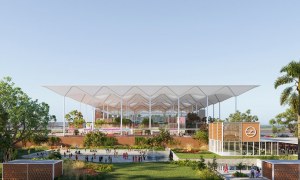🕑 Reading time: 1 minute
Boston Dynamics' famous robot dog, Spot, is widely known for its versatility. After demonstrating its ability to pull trucks, work on oil rigs, and even herd sheep, the canine-like bot is now surprising everyone with its role on construction sites.
The bot was recently seen helping Foster + Partners with its ongoing Battersea Roof Gardens project in London. The company's Applied Research + Development group (ARD) worked in collaboration with Boston Dynamics to use Spot to just roam around the Battersea project, and the result has been genuinely fruitful.
Spot used its 3D laser scanning technology to monitor and capture construction progress. The robot generated precise scans of the site, checking that the work executed matches the blueprints and ensured the propriety of the work. It was observed that the usual scanning and processing times required for this kind of project came down from weeks to just days, freeing up considerable staff resources.
Spot's ability to repeatedly and efficiently complete routine scans in a dynamic environment helped gather a large amount of high-quality data. A sequence of scans was generated through this process that helped with tracking the project progress against schedules and facilitated regular comparisons with the BIM model.
The scans can ensure that very quick and precise changes can be implemented to the newly designed system to manage the differences captured by the scans. This could contribute to savings both in terms of time and money.
Moreover, though construction sites are very hazardous and dynamic in nature, the robot was easily able to navigate through stairs and other obstacles using its four legs without any issue and could work semi-autonomously or be remote-controlled.

The bot is designed to go to places where other robots can't. It can perform a wider variety of tasks, such as automate documentation of project progress, monitor remote or hazardous sites, and provide situational awareness in remote settings.
Spot can be reconfigured for several use cases with a customizable modular platform. It can be equipped with a number of accessories, called payloads, to increase its efficiency and significantly reduce safety risks on sites.
In addition to their Battersea project, Foster + Partners also employed the bot to produce a digital twin of its London HQ. Along with other sensors inside the building, Spot's scans enabled the firm to get a better view of how the building is used over time and make improvements to its efficiency.
With this kind of collaboration and results, it's not too much of a stretch to imagine a team of Spot robots being commonplace on construction sites in the coming years. Certainly, with the inclusion of 3D-printing technology and bricklaying robots, the future of construction looks likely to feature such robots heavily, which may bring trouble for some human jobs.
Read More
Digital Twins in Construction: Applications and Advantages
85-Year-Old Building Walks on Robotic Legs to a New Location
Hydrodemolition: A Unique Concrete Removal and Surface Preparation Technique



